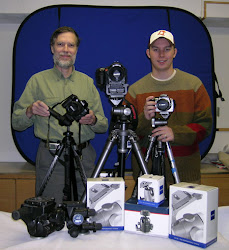We were all set to go on holiday when I had a brainwave that I wanted to upgrade my Fuji Compact Digital Camera. The Fuji produced pictures that were reasonable, well actually they were pretty good, but a friend of mine had recently purchased a DSLR (Digital Single Lens Reflex) Camera which produced absolutely great pictures. Having been a keen photographer in the past I looked into the difference between the old 35mm SLR Cameras and the modern day DSLR. My findings and overall conclusion were eye opening to say the least...
The old SLR camera was certainly a means of photography for the dedicated photographer with a lot of factors being involved in order to get the right shot, and certainly no means of viewing what you had captured until it was later developed by the chemist. To have been a wedding photographer back then must have been like living on your nerves every time a picture was taken, the uncertainty of its outcome must have been mind bending stuff.
When I discovered that a modern day DSLR was in no way anything like this for many reasons. The pictures taken can be instantly viewed on the LCD screen found at the rear of the camera, the camera itself has many innovative and beneficial built-in modes and features including automatic focus, and anti shake mechanisms giving clearer pictures even if the hands are a bit shaky.
Once I had been awakened to their magnificent performance and purpose it was simply a decision of choosing which one to get. After many nights reading review after review and report after report I came to the conclusion that the best manufacturer that ticked all my boxes was Sony and the choice of camera would be their entry level model the Alpha a200.
I decided on this model based on looking ideal for someone beginning or starting out with a DSLR camera, although a very powerful and highly capable camera with 10.2 megapixels and an 18 - 75mm wide angel macro lens as standard would produce some above average pictures for a below average experience person.
When I first started to use the Alpha I was learning something new about what it could do each and every day, added to that the high quality of photographs that it was producing lead me to wonder what this great camera cold do if I invested in some additional accessories.
Before long I had the standard camera and lens as well as a 28-200mm lens, which is good for close range pictures as well as fairly distant shots, a 70 - 300mm lens, which is more suited to longer distance shots such as the moon and distant aeroplanes. Added to that the 2x converter which once attached to a lens brings any distant images even closer, so when used with the 70 - 300mm it gives a distant range of 600mm, which produces some amazing images, and a set of magnifier lenses that make small things much, much larger especially insects.
Even now when I go anywhere I rarely leave the house without my Sony Alpha a200 and generally the 28 - 200mm lens attached. It seems such a long time ago since the Fuji compact camera, but a decision and step that I am more than happy that I took.
Related : Cheap Clothing Optional Galleries Store best sport goods store Best Cameras Digital Store






